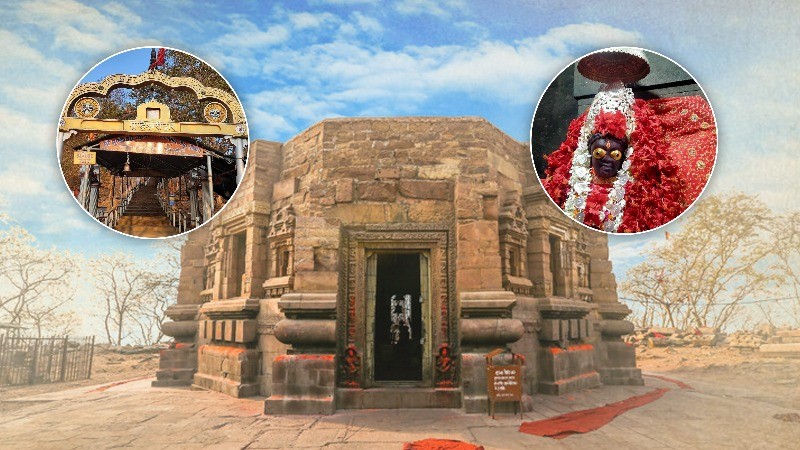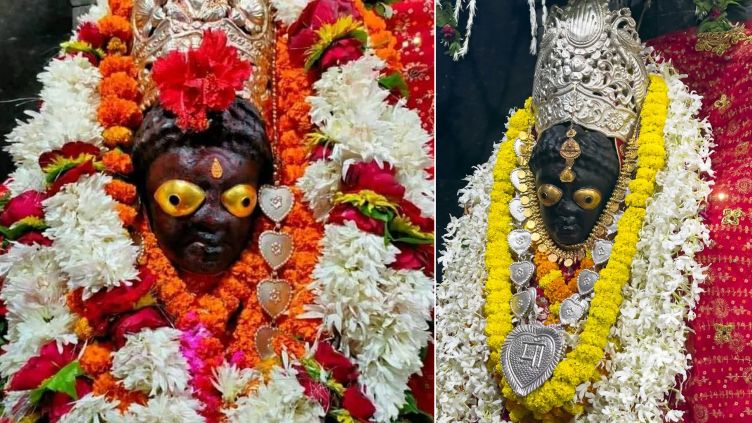
Civilizations built and washed away, empires ruled and collapsed, histories were made and rewritten, amid wrath and remains, what stood tall against the test of time is the Mundeshwari Devi temple of Kaimur, Bihar. It's historic, magnificent, fascinating, and a living testament to India's rich cultural heritage. Located in the Mundeshwari or Piwara Hills at an elevation of 600 feet, the temple is dedicated to Lord Shiva and Maa Shakti, also known as Goddess Durga. Mundeshwari Devi is known for its unique architectural brilliance and holds immense religious significance to this day. While most Hindu temples are built of brick and mortar, this stone-made marvel is an old-world wonder in existence.
Let's delve into the rich history, significance, and the world of Mundeshwari Devi, the oldest temple of India:
 The history of the Mundeshwari temple is also dated to the period of the Saka dynasty, before the Gupta Empire (Image source: Bihar Tourism, Government of Bihar)
The history of the Mundeshwari temple is also dated to the period of the Saka dynasty, before the Gupta Empire (Image source: Bihar Tourism, Government of Bihar)
According to the Archaeological Survey of India (ASI), the Mundeshwari Devi Temple dates back to 108 AD[1]. It is believed to have been originally built during the Gupta Empire in the 6th century CE[2]. While some historians also state that it has existed since the Mauryan period. However, what we witness at present must be around the 10th or 11th century CE. But various archaeological evidence and inscriptions here, supported by prehistoric settlements, reveal that the place has been worshipped even before the temple was constructed. An inscription of 389 AD is one such example that depicts the temple's ancestry.
Huang Tsang, a Chinese traveler, also mentioned the shrine on a hilltop in his account, which was later confirmed as the Mundeshwari Devi temple. A Brahmi script royal seal of the Sri Lankan King, Dutthagamani, was discovered at the site in 2003 CE, which suggests that the temple is even older, around the 1st or 2nd century BC. This further adds to the debate around the history of the temple.
The temple has been a protected monument since 1915, and is currently undergoing restoration.
 Mundeshwari Devi idol is installed in the main sanctum sanctorum of the temple
Mundeshwari Devi idol is installed in the main sanctum sanctorum of the temple The site has been a place of worship for 2500 years, even before the earliest known construction of the temple.
When Shaivism gained prominence during the 7th century AD, Viniteswara (a deity) presided over as a major deity. The Panchmukhi Lingam (five-faced lingam) at the central position represents him. It holds the same place even now, along with Nandi's statue on the western side of the main entrance. The lingam is made with a special stone, which changes its color along with the position of the Sun[1].
The Chero tribe, who are the original inhabitants of Kaimur Hills, rose to power after this period. They worshipped Shakti (Maheshamardini or Durga), as represented by Devi Mundeswari, who is believed to be an incarnation of the former. She has become a prominent deity since then. Her idol is installed separately along one side of the wall in the eastern section[1].
Both Shiva's lingam and Shakti's idol are housed in the temple's sanctum sanctorum (Garbhagriha). Therefore, the temple holds immense significance for the Hindu religion, where devotees can worship both Shiva and Shakti, the divine masculine and feminine energies.
Not only Hinduism the temple has also been a major pilgrimage site for Buddhism too, during the time of Gautam Buddha. Yoni Pitha inside is believed to represent a Buddhist Stupa.
Another significance of the temple is the fact that it has been continuously functioning. All the activities, customs, rituals, and traditions have been performed for ages, no matter the season, the rule, or the governance. Despite the region being a stronghold of Muslims, the Mundeshwari temple never faced any destruction, even during Sher Shah's rule.
What strikes visitors most is the goat sacrifice held at the temple. A unique one where the animal is sacrificed, but not slaughtered. When the goat is presented before the sanctum, and the priests begin with the rituals, the goat loses consciousness and appears dead. But, within no time, it is back again to life, as a miracle.
The Mundeshwari Devi temple is a stone-made octagonal temple, built in the Nagara style of architecture (with a square base, a curved superstructure, and a shikhara at the top), serving as the oldest specimen of its kind. It has four entrances, out of which one is closed, and one is half-open. The stone carvings in the temple were inscribed during the Gupta period[2]. Over centuries, there have been several additions to the temple, along wth many renovations. Out of the most distinct features of the temple is the square sanctum and the circular mandapa.
What's even more striking is that the temple is carved out of a single stone, said to be granite. Built using a method known as Dry masonry, the rock was cut and carved, with rock pieces placed one above the other.
The octagonal structure is formed by the eight projections at the corners. The conical-shaped superstructure has intricate patterns such as lotus petals, kalash (pots), and makara (a mythical creature mentioned in the Puranas). The base, or the circular Yoni-pitha, is made up of eight petals, which represent eight directions.
What makes the Mundeshwari Temple so fascinating and alluring are the legends, lore, and mythical tales associated with it. From Lord Rama to Goddess Durga, there are many famous legends of this religious abode.
One of the legends says that the Mundeshwari Devi Temple was built by Lord Rama himself when he visited the place during his 14 years of exile. It was when he saw Devi Mundeshwari in his vision, who instructed him to build a temple dedicated to her. It is also believed that the Lord could assemble the temple with a single rock.
Locals say that Goddess Durga manifested at the temple site to defeat and kill the demon Mahishasura.
While another one states that the temple was built to honor the Goddess after she emerged victorious after a demon named 'Mund' was slain by her. There is a prominent belief that the Goddess appeared from Mund's head after killing him.
By air: The Kaimur district doesn't have an airport. If you intend to visit by air, then you will have to land at Varanasi Airport, which is 60 km away. From there, you can reach the temple in a taxi[2].
By train: When travelling via train, it is suggested to reach Mohania station, also known as Bhabua Road Station. The Mohania station is a major railway junction in Kaimur, on the Howrah-New Delhi Grand Card in the Mughalsarai region. Kaimur is well-connected to other major cities of India and is easily accessible[2].
By road: Kaimur is connected to Bihar's capital, Patna (which is at a distance of 200 km) via Arrah through the NH 30. Varanasi is 100 km to Kaimur. After reaching Kaimur, you can book an easy commute, such as a bus or a cab[2].
Recognized hotels for a comfortable stay: Hotel Kohinoor (Bhabhua), Hotel Aryavart (Ramgarh road, Mohania, Kaimur).
When to visit: The best time to visit the Mundeshwari Devi Temple is during Ramnavami and Mahashivratri. Both festivals are celebrated with great fervor and joy. Thousands of devotees from faraway places visit to seek the blessings of Maa Mundeshwari during this time for prosperity, good health, and enlightenment[3].
The Mundeshwari temple exemplifies India's rich culture and heritage that echoes in its walls, stones, Shiva's lingam, and Shakti's idol, tales, and legends. The passage of time has led to a little disrepair, but it hasn't shed its glory. It still stands tall and magnificent as ever!
Maa Mundeshwari Temple. (n.d.). About Mandir. Retrieved June 3, 2025, from https://www.maamundeshwari.org/about-mandir